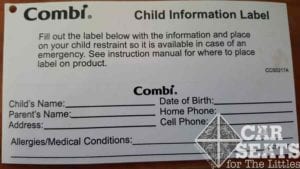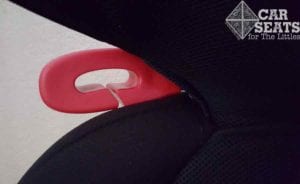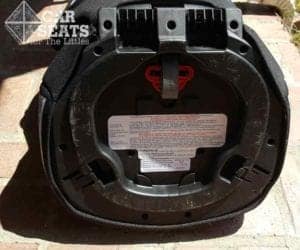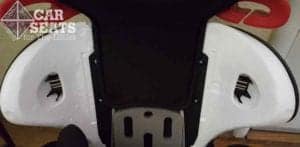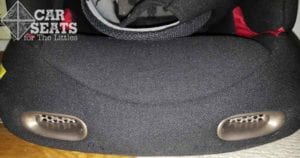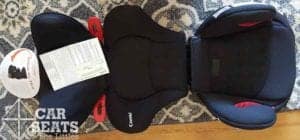The Combi Kobuk Air isn’t a new booster seat on the market but it’s one that we’ve been wanting to spend some time with. We finally got our chance when we ran into the Combi booth at the JPMA show! This lightweight booster seat has two modes: high back and backless. It also boasts a vented shell that keeps riders cool. Come along as we take a journey into my backseat.
CSFTL Quick Stats
- Top shoulder belt guide: 20.5 inches
- Expiration: 7 years
- Follows NHTSA’s crash replacement guidelines
- Weight range: 33-125 pounds
- Height range: 33-57 inches tall
Measurements
- Weight in backless mode: 2.8 pounds
- Weight in high back mode: 7.4 pounds
- Width at widest point: 17 inches across the back of the high back portion
- Seat area depth: 13 inches
- Seating area width: 9 inches
Elephant in the Room
I’m just going to address this RIGHT NOW. The Kobuk Air’s instructions say it’s approved for children who are at least 3 years old. There are 0 circumstances where we would agree with putting a child that young in a booster seat. The Kobuk Air has been around for a while — it was released at a time when younger kids were graduated through the stages of child passenger safety a lot sooner than they are now.
At least that’s the only reason we can think of why this ridiculously low minimum age would be there. Our stance is always geared toward best practice. We advocate that children be at least 5 years old before riding in a booster seat.
Many Names
Combi’s website refers to this booster seat as the Kobuk Booster Seat. The manual refers to the seat as the Kobuk Air-Thru Booster Car Seat. We’ll refer to it as the Kobuk to avoid any confusion.
Unique Features
ID Label
An ID label is included with the seat. The manual suggests that it be affixed to the back of the headrest. We’d like to add a note here: we can’t say for certain that any first responders would or would not look for such a label.
Side Wings
The Kobuk has some very deep side wings. It’s so deep that it almost gives my kiddo a hug. Some booster seats that have this type of shape don’t end up fitting well but the Kobuk’s shape offers a lot of support without squishing the child. I’d assert that a wide range of children would fit well in this seat.
As It Grows
The headrest adjusts easily by squeezing a handle on the back of the seat. The child’s head must be within the headrest and the manual states that the seat is outgrown when the top of the child’s ears are above the headrest.
Shoulder Belt Guides: High Back Mode
In high back mode, the Kobuk has some really interesting shoulder belt guides. They extend from the back of the seat and can move in or out, toward or away from the seat itself. When the shoulder belt guides are fully extended, the seat reminds me a bit of E.T.
This adjustment allows for a custom fit for every child. That’s a great thing!
One huge bonus? The vehicle seat belt did not slip out of these belt guides AT ALL. NOT ONE TIME during the course of this review.
Shoulder Belt Adjuster: Backless Mode
The shoulder belt adjuster is attached to the Kobuk on the seat’s bottom. It can be used in backless mode to achieve a proper belt fit in seating positions that don’t offer a proper fit without a little help. The manual includes very clear instructions on when to use the adjuster. This level of detail is a rare and wonderful thing.
Vented Shell
The shell is pretty unique — it’s got a number of holes that allow airflow both across the child’s back and under their legs. I was lucky enough to review this booster during warm weather so we had a chance to put this feature to the test.
At no time during this review did my kiddo complain about getting hot. She didn’t seem to sweat in the seat at all! Kiddos who are prone to overheating or just being hot could benefit from riding in this seat.
Assembly
Our Kobuk arrived in two pieces — the backless portion and the high back. To prepare it for use in high back mode, we had to assemble it.
As usual, review dog Leroy was ready to help.
Next, I connected the hooks on the end of the high back portion of the seat to the slots on the back of the backless portion of the seat.
Like a lot of booster seats, the instructions say to recline the back below level to attach these hooks. Once the pieces are attached, rotate the back portion up and it’s ready to go in high back mode!
Carrying the Kobuk
In my day, I’ve carted an embarrassingly large number of high back booster seats around. I drag them from the house to the car, to different cars, to friends’ houses, then back into my car and my house. I’ve encountered a wide range of base-to-back connections, which means that while I carried this large number of booster seats around, sometimes they stayed together without me having to contort myself so the backless portion didn’t come loose and start flapping in the breeze and sometimes they didn’t.
Of all those booster seats, the Kobuk is the most prone to flopping around of all of them. The only way to keep it in one piece as I roamed around was to contort myself around the back because the armrests are too narrow to grab onto. I’d grab onto the underside of the backless portion while wrapping my upper body around the high back portion. That seemed to work but each time I moved the seat, I wished that it wasn’t about to flop around.
Three Across
At the widest point, across the child’s shoulder, the Kobuk Air only measures 17 inches wide in high back mode. The base of the seat is slightly narrower. This is pretty darn narrow for a booster seat so it might be a great option for tight spaces.
Fit to Child
High Back Mode
6 Years Old
Our 6 year old model is 63 pounds and 53 inches tall. He has room to grow in the Kobuk and found it comfortable, though he did note that the fabric on the head rest felt different from the smooth fabrics on his other seats. The Kobuk’s adjustable shoulder belt guides meant that we got a picture perfect belt fit on his shoulder. He needed help reaching to buckle especially in cars with lower or recessed buckle stalks.
8 Years Old
My favorite 8 year old weighs 67 pounds and is 51 inches tall. She had a bit of a challenge getting the vehicle seat belt buckled because the lap belt guide is astonishingly narrow. When I was setting the seat up, the loop in my vehicle seat belt closest to the car door kept getting stuck on the outside of the belt guide. I had to flatten the loop so I could slide it through the belt guide.
Once I got that set up, the loop didn’t cause any further issues but on the other side of the seat, my booster rider struggled to buckle herself in. She finally figured out that if she put both the lap and shoulder portions of the vehicle seat belt together, then slid them both through the guide at the same time, she was able to buckle with less struggle. It was definitely the biggest challenge when it came to using this seat.
The manual clearly instructs that the headrest height should allow the vehicle seat belt to be at or above the child’s shoulders and properly centered across the child’s shoulder.
Backless Mode
Because the Kobuk flops apart so easily, converting it to backless mode was quite simple. It’s as if the booster feels that its meant to be backless.
8 Years Old
Once again, our 8 year old model had a seat. She’s still 67 pounds and 51 inches tall. The Kobuk fit her reasonably well.
The shoulder belt didn’t fit squarely across her neck. While the seat still provided a decent belt fit, I’d prefer that it lay squarely across the center of her shoulder. Using the shoulder belt adjuster helped that but she refused to pose for a picture with it on. She was NOT fond of the way the adjuster felt on her back.
Important Information: Where to Find
Date of Manufacture label: The date of manufacture label is on the bottom of the seat.
FAA label: Like all booster seats, the Kobuk Air cannot be used on airplanes.
Manual storage: The manual stores on the bottom of the seat’s base. The back cover of the manual itself has a very nice diagram of this location.
Overall Thoughts
The Kobuk has a lot going for it — it’s lightweight, fairly long-lasting, and offers a consistently good vehicle seat belt fit. The biggest challenges we faced were buckling the vehicle seat belt through the lap belt guides and carrying it around. Families who don’t find themselves moving booster seats between vehicles too often (or who don’t mind contorting themselves around the seat to move it) and/or families who have children who are prone to overheating will find a solid choice in the Kobuk Booster Seat.


